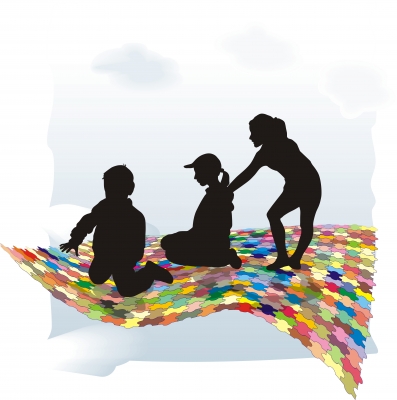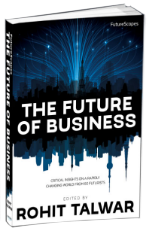08 Oct Scenarios with Children – How A Class of 1st Graders Sees Life in 2026
 I keep turning back to a scenario project I did with a group of 1st graders in 2011. This was a regular class at a public school in Austin where the goal was to inspire the children to think creatively about their own future and life in the year 2026. This session yielded some particularly intriguing insights. I’m tempted to use the word ‘prophetic’. Ok, I did give them some leads a few times, but keep reading and you will see what I mean. Scenario techniques are central to the discipline of Future Studies/ Strategic Foresight, and seek to help people and organizations build coherent images of various alternative futures. Most often scenario workshops are limited to strategic levels in larger organizations and their stakeholders and field experts. It is often implemented to help organizations prepare for an uncertain future. But scenario approaches are very useful with children too. Because who really need to prepare for an uncertain future more than the ones who have most of life ahead of them? As judge in the Texas Future Problem Solver competition I have been able to witness sage analysis and imagination from children who are just entering their adolescent years. Of course, “future problem solver students” are older and comprise the select few who made it into the ‘Gifted and Talented program’, so the expectations are higher. But I have found doing scenario projects with any children who are curious about their own futures to be highly fruitful. The technology age gap is decreasing sharply between adults and children, some might even say to the point where children know more than adults. They are the future costumers and producers of technology and content we might learn a lot about their desires and priorities just by listening to their ideas. Moreover, despite their limited knowledge, their views and imagination are not clouded by outdated perceptions. (Seriously, some of us old fogies haven’t even passed the old cold war dichotomies!)
I keep turning back to a scenario project I did with a group of 1st graders in 2011. This was a regular class at a public school in Austin where the goal was to inspire the children to think creatively about their own future and life in the year 2026. This session yielded some particularly intriguing insights. I’m tempted to use the word ‘prophetic’. Ok, I did give them some leads a few times, but keep reading and you will see what I mean. Scenario techniques are central to the discipline of Future Studies/ Strategic Foresight, and seek to help people and organizations build coherent images of various alternative futures. Most often scenario workshops are limited to strategic levels in larger organizations and their stakeholders and field experts. It is often implemented to help organizations prepare for an uncertain future. But scenario approaches are very useful with children too. Because who really need to prepare for an uncertain future more than the ones who have most of life ahead of them? As judge in the Texas Future Problem Solver competition I have been able to witness sage analysis and imagination from children who are just entering their adolescent years. Of course, “future problem solver students” are older and comprise the select few who made it into the ‘Gifted and Talented program’, so the expectations are higher. But I have found doing scenario projects with any children who are curious about their own futures to be highly fruitful. The technology age gap is decreasing sharply between adults and children, some might even say to the point where children know more than adults. They are the future costumers and producers of technology and content we might learn a lot about their desires and priorities just by listening to their ideas. Moreover, despite their limited knowledge, their views and imagination are not clouded by outdated perceptions. (Seriously, some of us old fogies haven’t even passed the old cold war dichotomies!)
Anyway, here are some golden nuggets: 
- They intuitively grasp the next chapter in computer technology – even augmented reality with 3D visualizations. They want smaller and larger screens for different purposes. Recent research does indeed show that kids are not ditching big-screens like the TV. It’s just that different screen sizes have different purposes. They also called for books that show 3D pictures when you point at it. Now two years later we have Cypher Kids Club and Animin. Not to mention Google Glass, of course.
- They believe renewable energy could be mined from a vast arsenal of alternative sources. Kids’ overwhelming trust in solar as the next source of energy is backed by solid analyses that predict that solar is poised to explode in the U.S within a few years. We are just now reaching cost parity making solar soon outcompete the traditional fossil fuel based grid. In the U.K., you can even get your solar panels at IKEA now! The kids looked beyond solar and saw a logical continuation by harvesting the energy produced by our bodies (kinesthetic energy, which has been demonstrated scientifically here), from lightning (which has been demonstrated scientifically here) and from stars beyond our sun.
- Kids feel rigorous expectations at school and wish for high tech aids, such as robotic tutors and mechanic page turners. Their attitudes toward school revealed mixed attitudes towards school. They love school. They love to learn. But they are also intimidated by school. Some of these first graders had older siblings and had probably witnessed their love of learning turn to frustrations and hours of test prepping. Again these kids are highly tuned to technological aids to make homework easier, and I think we will see academic help videos like those from Khan Academy play a role at younger and younger ages. This generation would be prime candidates for ‘flipped classrooms’. School shootings and the possibility of school turning into a danger zones resonates with this generation. One student wondered if there would ever be a need for army protection at school. And this was before the Sandy Hook tragedy.
 They expect innovations like: cars that can drive themselves, modular homes, cloning of pets and people, and the convenience of making your own clothes with a 3-D printer. At first they needed a little nudge anticipating disruptive changes in manufacturing and technology. But once they were explained the concept of self driving cars and computer printers that can print out things in various materials, they didn’t bat an eyelash. It needs to be said that two years later, students from this school presented 3-D printed items at the science fair. There is an overrepresentation of families headed by parents in STEM related industries.
They expect innovations like: cars that can drive themselves, modular homes, cloning of pets and people, and the convenience of making your own clothes with a 3-D printer. At first they needed a little nudge anticipating disruptive changes in manufacturing and technology. But once they were explained the concept of self driving cars and computer printers that can print out things in various materials, they didn’t bat an eyelash. It needs to be said that two years later, students from this school presented 3-D printed items at the science fair. There is an overrepresentation of families headed by parents in STEM related industries.
 They are native disciples of the emerging sharing economy. Their emphasis on sharing came spontaneously after looking at my population projection graph which shows that we are already challenging the upper limits of our bountiful earth. In case you didn’t know, we will be 9 billion when these kids are adults and in the industrialized world we already consuming the equivalent of 3-5 planets! The idea that you don’t have to own stuff as long as you have easy access when you need it was theirs alone. And subsequently, these ideas have caught on and are quickly dispersing to areas outside hipster communities in urban areas. Alternative economies and complimentary currencies are quickly pollinating areas of the economy traditionally dominated by hierarchical, often inefficient and sometimes corrupt money markets. The sharing economy could be seen as a central element of this trend. I didn’t do anything to nudge the kids along here, and I actually thought their ideas were a bit too idealistic at first. But as they grow up, these kids will be spearheading a trend where ownership and accumulation of things are not necessary or even desirable. Sharing is deeply felt with this generation and it comes from the heart, not from religion, adult authority or imposed moral obligations. In fact many children today are actively looking for opportunities to help others during the little they have of leisure time. A fairly new trend among birthday children is to ask for donations for a special cause instead of presents. The latest research from Jean Twenge’s team, the author behind the Narcissism Epidemic, does indeed show the recession had a pro-social effect on the younger generations.
They are native disciples of the emerging sharing economy. Their emphasis on sharing came spontaneously after looking at my population projection graph which shows that we are already challenging the upper limits of our bountiful earth. In case you didn’t know, we will be 9 billion when these kids are adults and in the industrialized world we already consuming the equivalent of 3-5 planets! The idea that you don’t have to own stuff as long as you have easy access when you need it was theirs alone. And subsequently, these ideas have caught on and are quickly dispersing to areas outside hipster communities in urban areas. Alternative economies and complimentary currencies are quickly pollinating areas of the economy traditionally dominated by hierarchical, often inefficient and sometimes corrupt money markets. The sharing economy could be seen as a central element of this trend. I didn’t do anything to nudge the kids along here, and I actually thought their ideas were a bit too idealistic at first. But as they grow up, these kids will be spearheading a trend where ownership and accumulation of things are not necessary or even desirable. Sharing is deeply felt with this generation and it comes from the heart, not from religion, adult authority or imposed moral obligations. In fact many children today are actively looking for opportunities to help others during the little they have of leisure time. A fairly new trend among birthday children is to ask for donations for a special cause instead of presents. The latest research from Jean Twenge’s team, the author behind the Narcissism Epidemic, does indeed show the recession had a pro-social effect on the younger generations.
 When they grow up SpongeBob will be old and brown. I loved this one! It’s actually very possible that SpongeBob will age faster than the kids he entertains because when it comes to the Homelander generation, it feels good to be a kid. And despite the well-established notion that kids are growing up faster, they are absolutely in no hurry to grow up.
When they grow up SpongeBob will be old and brown. I loved this one! It’s actually very possible that SpongeBob will age faster than the kids he entertains because when it comes to the Homelander generation, it feels good to be a kid. And despite the well-established notion that kids are growing up faster, they are absolutely in no hurry to grow up.
Images: Vlado, Victor Habbick and stockimages @FreeDigitalPhotos.net and Mark Doliner, davidd @ Flickr (CC), U.S. Dept. of Energy


Sorry, the comment form is closed at this time.